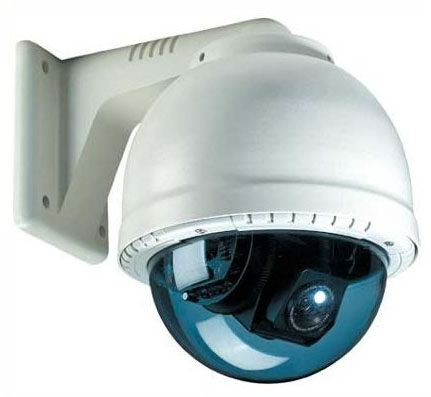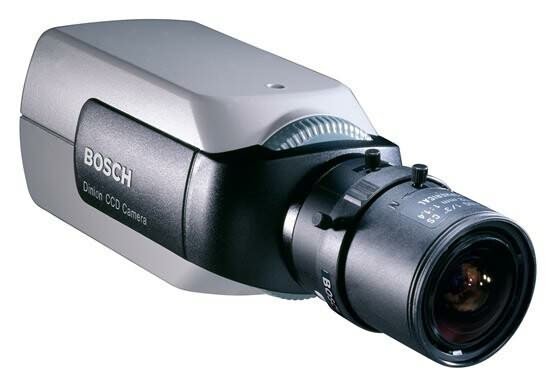Components of a CCTV System
There’s a lot that goes into a successful CCTV installation. While the cameras get most of the attention in the beginning, you also have other concerns, such as viewing, recording, and archiving the video footage, and the equipment required for carrying out those tasks. Here’s a look at the basic components of a typical CCTV system.
Security cameras are the starting point for most CCTV systems. There are endless possibilities when choosing CCTV cameras and lenses – everything from fixed models designed for monitoring very specific locations, to day/night cameras, and powerful PTZ domes for patrolling large areas.
Monitor
In a traditional CCTV setup, operators view footage from a central location on a monitor very much like a TV, but with higher lines of resolution for better picture quality. Monitors can be dedicated (meaning they display video from a single camera), or call-up (meaning operators can access multiple cameras at the same time).
DVR
Most modern CCTV systems incorporate DVRs (digital video recorders) which enable operators to reap some of the benefits of a network-based surveillance setup. DVRs convert the analogue footage to digital, which helps to extend storage capacity, makes it much easier to search archived footage, and also allows users to stream video over a network for remote viewing from multiple locations.
Types of CCTV Security Cameras
Fixed Box Camera
Fixed CCTV cameras point in a single direction, w
hich makes them perfect for monitoring very specific areas of interest. They’re also preferred for applications where it’s beneficial to install cameras in clearly visible locations. For this reason, fixed cameras are quite effective not only for capturing footage of suspicious activity, but also for deterring criminals and vandals from carrying out their acts in the first place. The direction of the camera is set during installation. Many cameras also accept interchangeable lenses and housings, so you have the flexibility to meet a wide variety of surveillance needs.
Fixed dome camera
We offer a wide range of high resolution dome cameras. The cameras are covered with a doom shaped covering to protect the in-built camera from damage. They are widely used for keeping surveillance in all major corporate offices and public places for security purposes.
PTZ
PTZ cameras are ideal for wide-area surveillance. They give operators the ability to remotely control pan, tilt, and zoom functions to follow activity and to zoom in for detailed monitoring. This is an area where analogue CCTV cameras fall behind their IP camera counterparts. With IP cameras, the pan/tilt/zoom functions are controlled manually or automatically and delivered over a single network cable, while analogue cameras require additional wiring to perform similar functionality.
IR Camera
We provide Vandal-proof dome camera with D&N mini dome with 24 IR LEDs, 3.5 mm lens and 12 VDC power. These doom cam have tamperproof mini dome camera with IR LED fitted on three-axis adjustable support with average resolution of 420 lines. The camera is provided with fixed 3.5 mm lens and is provided with auto-shutter circuit for adjusting exposure in environmental conditions subject to light variations. The camera does not need particular adjustments. No commands need to be programmed and therefore this is the ideal solution for quick and easy installation. Also, in poor light conditions, a sensor switches the IR LEDs on for night vision.
CCTV System Management and DVR Recording
DVR Recording CCTV Video Management
It wasn’t long ago that most surveillance systems used VCRs to record individual video streams. The footage was recorded either continuously or triggered by an event, and recorded on cassette tape usually at a rate of 25 frames per second. Back in the day, this seemed like an advanced solution. But now we know, regardless of what type of surveillance cameras you’re using, storing video footage on cassette tapes is not a very effective strategy. The tapes take up space, can’t hold very much information, and they’re incredibly difficult to search through if you need to pinpoint video images of a specific event.
Enter the digital video recorder (DVR).
DVRs make it possible for users to convert analogue CCTV video to digital, allowing for remote monitoring, greater storage capacity, and quick and easy searches. Think of the DVR as a cost-effective solution for those not yet ready to move to a full-on IP surveillance setup. Digital video recorders allow you to bring your analogue CCTV cameras into the modern age. When footage is converted to digital, new worlds open up in terms of how you can view and manage your video feeds.
What is a DVR?
What is a Digital Video Recorder?
A Digital Video Recorder (DVR) contains software, video storage, and a computer hard disk all in a single unit. The DVR accepts analogue video feeds and converts them to digital. It’s a cost-effective way to bring an analogue CCTV system into the modern world, and provides some of the same benefits as IP video, but in a more budget-friendly solution.
Advantages of Digital Video Recorders
Benefits of DVR Recording
DVR recording is a great way to migrate your analogue CCTV into a digital surveillance solution. This is a low-cost option that brings a number of benefits to those who already own analogue cameras, or aren’t yet ready to make the move to a fully IP-based surveillance system.
Remote Monitoring
In the past, conventional CCTV systems could only transmit video to a single monitoring station, but that’s not the case when you’re using a DVR. Most digital video recorders now allow you to access your camera footage remotely over the internet. By connecting your analogue cameras to a DVR, you can monitor video feeds in real time from any computer with internet access, and even from compatible cell phones or handheld PDAs.
Digital Storage
Not long ago, most surveillance systems could only record to VHS cassette tape. Recording to tape has many drawbacks. For one, the tapes are bulky and take up a lot of space. Additionally, trying to search the recorded footage on analogue tape can be a time-wasting nightmare. With DVRs, your footage is converted from analogue to digital, so you can store significantly more video without the clutter, and it’s much faster and easier to sort through archived footage.
Video Compression
To make the most of available storage capacity, DVRs provide a number of different compression technologies. Common compression formats include Motion JPEG, MPEG-4, and H.264. With video compression, your files sizes are reduced as much as possible without compromising image quality.
Secure Connectivity
Most digital video recorders offer password protection so only authorized users are able to access the video footage from remote locations.
Hybrid DVRs
Hybrid DVRs are unique in that they can support both analogue CCTV cameras and IP network cameras. This level of flexibility isn’t available with traditional DVRs, which only connect to analogue cameras. Hybrid DVRs ease the transition from analogue to IP surveillance. Since they support both camera types, you don’t have to restrict your camera options. This makes it easy to move towards an IP-based solution while still using lower-cost analogue cameras when necessary.
IP Camera?
What is commonly known as an IP camera, is a camera that digitizes and processes analog images, encodes them internally, and then transmits the video information digitally over an Ethernet connection to a computer or similar device. An IP camera can have either a CMOS or a CCD sensor, and is available in the same styles as traditional surveillance cameras such as Pan/Tilt/Zoom, domes, bullets, box, infrared, covert, and wireless.
IP cameras are typically equipped with an embedded web server and can be accessed and controlled over any IP network such as a WAN, LAN, Intranet, or Internet. By utilizing a standard web browser or client software users can view an IP camera’s video output from any local or remote location.
IP cameras combine the capabilities of a camera with some PC functionality, do not require a direct connection to a PC to operate, and can be placed anywhere within a network. Just like any other PC on the network, an IP camera is a “network appliance”.It has its own IP address, connects directly to a wired or wireless network and requires maintenance.
What is the Difference Between an Analog and an IP Camera?
The principle difference between analog and IP cameras is the method by which the video signal is transmitted and, ultimately, where the video is compressed, or ‘encoded’.
Advantages of IP Video over Standard CCTV
The advantage of an IP based system over analog CCTV is clear, and by that we mean literally – better picture quality. After all, the whole point of a Video Surveillance System is to see exactly what is going on. How many times have you heard about or seen grainy footage of a perpetrator committing a crime that was taken by a traditional CCTV system? Most often you can’t make out more than a fuzzy form and the images are useless to law enforcement. The fact is that traditional CCTV cameras have reached the end of their evolution and can not compete with high resolution Digital IP Surveillance Cameras.
Megapixel Resolution vs. Analog’s Highest Resolution
Don’t be fooled by what many competitors claim is high resolution or even high definition CCTV..
The following 2 pictures help illustrate this point by comparing a 1.3 Megapixel IP Camera to a supposed
“high resolution” analog camera running at 4CIF.
In picture 1, both cameras are aimed to show the same coverage area, basically a square area covering the entrance from top to bottom and side to side. The 1.3 MP image results in an image more than 3 times as big as the analog camera. That larger picture of the same area translates into more image detail and clearer image quality.
Picture 2 demonstrates a situation where increased coverage area is desirable over increased detail. The 1.3 MP IP Camera covers three times the area as the analog camera which translates into a need for fewer cameras.
With higher tier IP cameras surpassing the 10 megapixel benchmark, it is clear that analog CCTV has been outdone.
Even at the highest resolution available for CCTV, the clarity of rapidly moving objects – such as a person running or speeding car – has long been problematic in security and surveillance applications. In an analog CCTV environment, a rapidly moving object will appear blurry. This is because an analog video signal, even when connected to a DVR, interlaces to create the images. Interlaced images use techniques developed for analog TV monitor displays, made up of visible horizontal lines across a standard TV screen. If you happen to have shopped for a new TV lately you are probably aware that 1080i is not nearly as good as 1080P. Interlacing divides images into odd and even lines and then alternately refreshes them. The slight delay between odd and even line refreshes creates some distortion – only half the lines keep up with the moving image while the other half waits to be refreshed. This causes moving objects to blur or appear jagged (see Illustration 1).
Network Video Server vs. DVR
Many competitors claim that a DVR based system qualifies as an IP based system. Although DVR’s do record digitally and are better than VHS based systems, they are still not truly digital and can not be classified as IP. DVRs essentially take an analog signal, convert it to digital format and then compress it, all of which typically reduces quality. IP signals on the other hand begin as digital and remain that way. IP based systems are also less complicated than clunky DVRs and are designed to be end user friendly. In addition, with an IP based system you can have from one to any number of cameras, whereas DVR based systems typically require that you start or move up in blocks of 4, 8 or 16.
There are many other advantages to IP based systems such as increased recording time, smart search capabilities, web based remote viewing, Access Control tie ins, easy system upgrades – the list goes on and on. Digital Provisions will be happy to explain all of these advantages to you and demonstrate how they will benefit your business. Most often in the end our customers are content simply knowing that their IP Based Video Surveillance system is recording the information they need it to all in exceptional detail and clarity.
CCTV Resolution for IP Cameras
Next, we’ll cover CCTV resolution for IP cameras. IP cameras (megapixel specifically) are able to deliver a much higher resolution. Firstly, a MP camera is already digital so there is neither conversion nor compression. Secondly, MP cameras run their signal through Cat 5 or 6 which allows for a much higher transfer of data.
1.3M is generally the smallest resolution of IP megapixel camera, but is still quite a bit larger resolution than any analog cam. Even though this is a huge jump from analog, if this is not enough you can jump to 3.0 megapixel and get a 2048×1536 resolution. Still want bigger? Go with the 5 megapixel for a 2592×1944 for a HUGH image.
If analog resolutions are not cutting it for you, IP surveillance cameras can definitely accommodate any large resolutions.
The Transition from CCTV to IP Video
Converting from Analogue to IP Surveillance
It’s no secret that the future of video surveillance is in IP-based solutions, but that doesn’t mean you need to throw out your existing analogue cameras as you make the transition. Cutting-edge surveillance equipment such as hybrid DVRs and video encoders allow you to build a future-proof IP surveillance network while retaining the analogue security cameras you already have on hand.
Hybrid Analogue/IP Systems
There’s a difference between a DVR-based system and a hybrid surveillance system. With a standard DVR setup, you’re limited to using only CCTV cameras. The analogue video signals are sent to a DVR where the footage is then converted to digital. In a hybrid system, you have the option of using both IP network cameras and analogue cameras, all operating together on the same network. This is typically done by using video encoders and servers, or a hybrid DVR.
Video Encoders Servers
A video encoder (also known as a server) digitizes analogue video signals so they can be sent directly over an IP network. This enables users to view live video images using a standard web browser or with video management software on any local or remote computer with network access. Best of all, the digitized footage from the analogue cameras is traveling along the same IP network as any new IP cameras you add, so you can view footage from all your cameras the same way.

















































